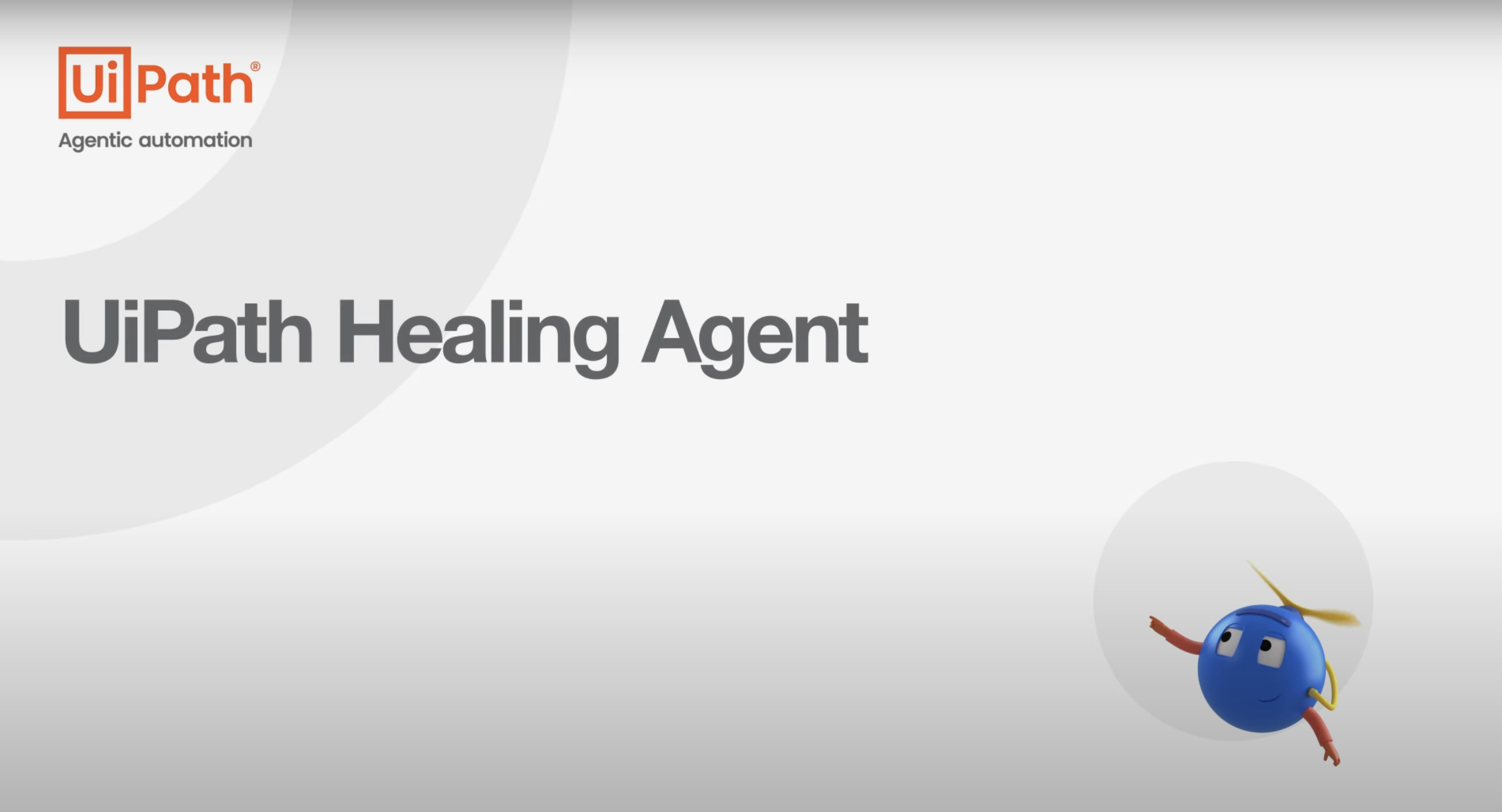Technical Tuesday: How UiPath Healing Agent solves UI automation's biggest challenges
Share at:

Why self-healing matters
The promise of user interface (UI) automation is compelling—robots that can navigate applications, fill out forms, and process data with the precision and speed that humans simply can't match. Yet for many organizations, this promise remains frustratingly elusive.
Despite investing significant resources in automation development, teams can find themselves devoting significant resource to maintenance cycles, troubleshooting, and firefighting when their automations struggle with new elements like UI changes.
UiPath Healing Agent represents a fundamental shift in how to enhance UI automation resilience. By combining AI-powered recovery strategies with deterministic logic, it transforms rules-based automation into adaptive, self-healing systems that continue running even while applications evolve around them.
The result is a new paradigm where automation maintenance evolves from reactive to proactive, and robots become truly autonomous rather than depending on human intervention.
The hidden cost of fragile automations
UI automation has historically been challenging due to the dynamic nature of modern applications. User interfaces constantly evolve—labels get renamed, buttons move, new pop-ups appear, and layouts shift to accommodate new features. These changes, while often minor from a user perspective, can be highly disruptive for automation scripts that rely on precise element identification.
According to EY’s comprehensive study, 30% to 50% of initial automation projects fail to meet their intended objectives. This failure rate represents a significant issue for organizations investing in automation technologies, with the primary causes stemming from the inherent brittleness of traditional automation approaches.
One of the most significant challenges facing robotic process automation (RPA) implementations is the maintenance burden that accompanies robot deployment. Forrester research shows that over 50% of RPA projects can’t grow beyond ten robots, with scalability challenges directly linked to the maintenance overhead that increases exponentially as automation portfolios grow.
UI changes are the primary cause of robot failures, with selector-based automation particularly vulnerable to modifications in application structure. When applications undergo updates, the element selectors that robots rely on can become invalid, causing automation scripts to fail until manual intervention resolves the issue.
The financial impact of these failures extends beyond direct maintenance costs. Robot repair times can range from a few hours to days and even weeks, depending on the complexity of the issue and the availability of documentation. During this downtime, business processes that depend on automation must revert to manual execution, eliminating the efficiency gains that automation was designed to provide.
Introducing UiPath Healing Agent: a revolutionary approach
UiPath Healing Agent addresses these fundamental challenges through a sophisticated self-healing approach, combining AI with deterministic recovery strategies. Rather than simply logging failures and stopping execution, Healing Agent actively analyzes problems in real time and applies the most appropriate recovery methods to keep automation running.
The agent operates on just-in-time (JIT) analysis, performing real-time examination of UI elements and application state at the moment of failure. This approach allows Healing Agent to understand not just what went wrong, but why it went wrong and what alternatives are available. The system maintains a comprehensive understanding of the automation's intent, enabling it to make intelligent decisions about how to proceed when the original plan encounters obstacles.
Intelligent recovery strategies form the core of Healing Agent's capabilities. When a selector fails, the system doesn't simply retry the same approach—it analyzes the current UI state, identifies alternative elements that match the original intent, and dynamically updates the automation to use the most appropriate option.
The system's dual-mode operation provides both immediate recovery and long-term improvement. In self-healing mode, Healing Agent automatically applies fixes and continues execution, ensuring business continuity. In recommendation mode, it captures detailed information about failures and suggests specific fixes that developers can review and apply to prevent future occurrences. Lastly, semantic understanding enables Healing Agent to recognize when UI elements have changed in meaning rather than just appearance. For example, if a label changes from "First Name" to "Given Name," the system understands these represent the same concept and adjusts accordingly.
To understand how these capabilities work together, watch how Healing Agent helps recover an unintended automation:

How Healing Agent works: the technology behind self-healing
The technical architecture of UiPath Healing Agent represents a significant advancement in automation resilience. The system employs multiple complementary technologies to achieve robust self-healing capabilities. Our multi-strategy recovery engine serves as the foundation of Healing Agent's intelligence. When an automation encounters a failure, the system evaluates multiple strategies simultaneously and selects the most appropriate one based on the specific failure context:
Selector regeneration: when element attributes change, Healing Agent analyzes the current UI structure and generates new selectors that maintain the same targeting intent while adapting to the new element properties
Semantic targeting: the system leverages natural language processing to understand when labels or descriptions have changed meaning while maintaining the same functional purpose
Computer vision fallback: if traditional selector-based approaches fail, Healing Agent can switch to image-based recognition using screenshots captured during the original automation development
Intelligent wait strategies: rather than using fixed timeouts, the system dynamically adjusts wait times based on observed application behavior and current performance conditions
Obstruction management addresses one of the most common causes of automation failure—unexpected pop-ups, overlays, and modal dialogs. Healing Agent intelligently categorizes these obstructions and applies appropriate handling strategies. Furthermore, cascade recovery processing enables Healing Agent to apply multiple recovery strategies in sequence when complex failures occur. For example, it might first close an interfering pop-up, then adjust a selector, and finally apply a smart delay to wait for page loading—all in a single recovery cycle.
How Healing Agent enhances automation
The advantages of Healing Agent extend far beyond simple failure recovery. It fundamentally changes how organizations approach automation design, deployment, and maintenance.
Proactive automation design: teams no longer need to anticipate every possible UI variation. Developers can focus on core business logic rather than defensive programming, knowing that Healing Agent will handle unexpected changes gracefully.
Earlier automation adoption: organizations feel confident that their automation investments won't become maintenance burdens. Teams can begin automating processes earlier in application development cycles, knowing that UI changes won't immediately break their work.
Enhanced scalability: automation programs are no longer limited by maintenance capacity. Organizations can deploy more automations across more processes without proportionally increasing support requirements.
Risk mitigation: automation becomes more predictable and reliable. Business processes that depend on automation experience fewer disruptions, leading to better service levels and reduced operational risk.
Integration with existing automation frameworks
One of Healing Agent's key strengths is its seamless integration with existing UiPath automation investments. Organizations don't need to rebuild their automation portfolios to benefit from self-healing capabilities.
Backwards compatibility ensures that existing automations can benefit from Healing Agent capabilities with minimal modification. The system works with current UiPath projects by simply updating the UI Automation Activities package and enabling Healing Agent at the process level.
Governance integration allows organizations to maintain control over healing behaviors through the UiPath AI Trust Layer. Administrators can configure whether Healing Agent should automatically apply fixes or only provide recommendations, ensuring alignment with organizational risk tolerance and compliance requirements.
Finally, monitoring and analytics provide comprehensive visibility into healing activities through UiPath Insights. Organizations can track healing success rates, identify patterns in failures, and optimize their automation designs based on real-world performance data.
The future of resilient automation
UiPath Healing Agent represents more than just a feature enhancement—it’s an evolution of how we conceptualize and implement automation. It demonstrates that automation can be both powerful and resilient, autonomous and controlled, sophisticated and reliable.
The complexity of modern approaches continues to increase, UIs become more dynamic, and the pace of change accelerates. Traditional approaches to automation maintenance simply cannot scale to meet these demands.
For organizations serious about automation success, exploring self-healing technologies like Healing Agent could be a game-changer which can help break traditional maintenance cycles that limit automation's true potential. The technology exists today to transform automation from a powerful but deterministic approach into a robust, adaptive capability that creates more value over time.
Want to see self-healing automation in action?
UiPath Healing Agent is now generally available! Whether you're just beginning your automation journey or looking to optimize existing investments, UiPath Healing Agent provides the resilience and reliability that modern automation demands.
Watch our TAM Talks webinar for a deep dive on the capability and to see how Healing Agent can transform your automation program.
You can also learn more by visiting the UiPath documentation or contacting your UiPath representative to discuss implementation strategies for your specific environment.

Technical Account Manager, UiPath
Get articles from automation experts in your inbox
SubscribeGet articles from automation experts in your inbox
Sign up today and we'll email you the newest articles every week.
Thank you for subscribing!
Thank you for subscribing! Each week, we'll send the best automation blog posts straight to your inbox.



